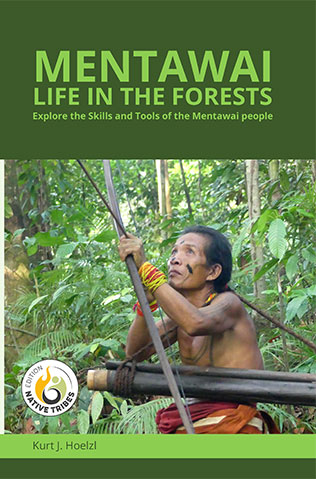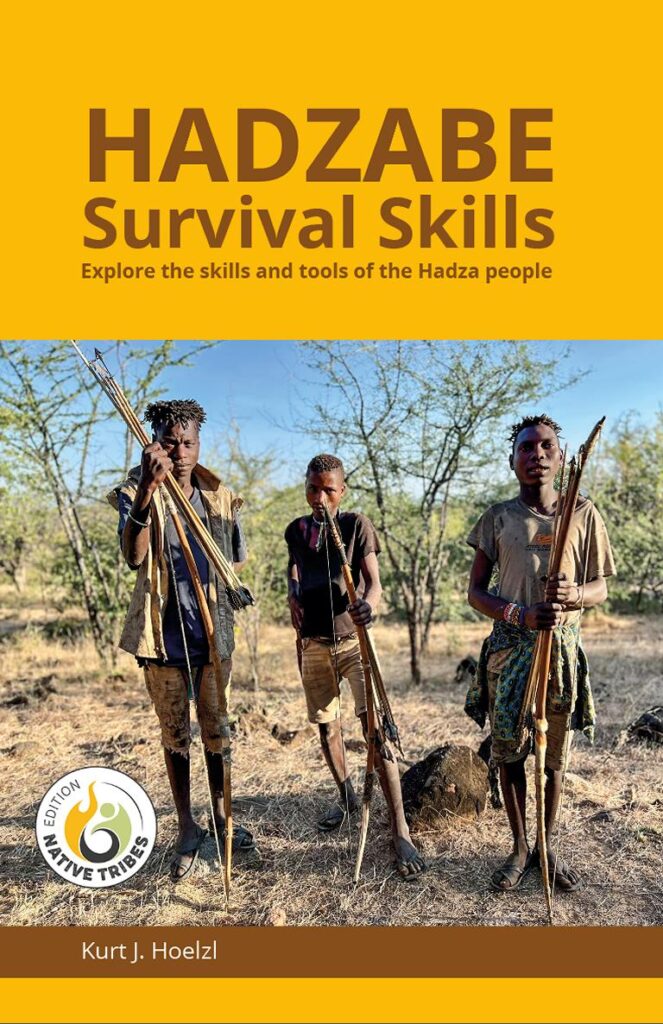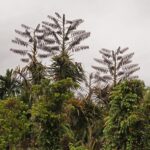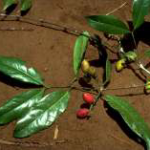Wild Sweetpea (Vigna frutescens) tubers are a staple source of starchy food for the Hadza people in Tanzania. The plant’s common name in the Hadza language is //ekwa. To collect them, groups of Hadza women regularly head out into the bush for harvesting, and some men accompany them for protection against possible dangers.

Description of the Wild Sweetpea plant
Vigna frutescens is a shrub with thin stems that either scramble over the ground or twine into the surrounding vegetation for support. The silvery-barked and twisted stems grow from a woody rootstock underground. These stems are usually 0.5-1.5 m long but can be up to 4 m long when supported by other plants. The leaves are pinnate and divided into three leaflets.
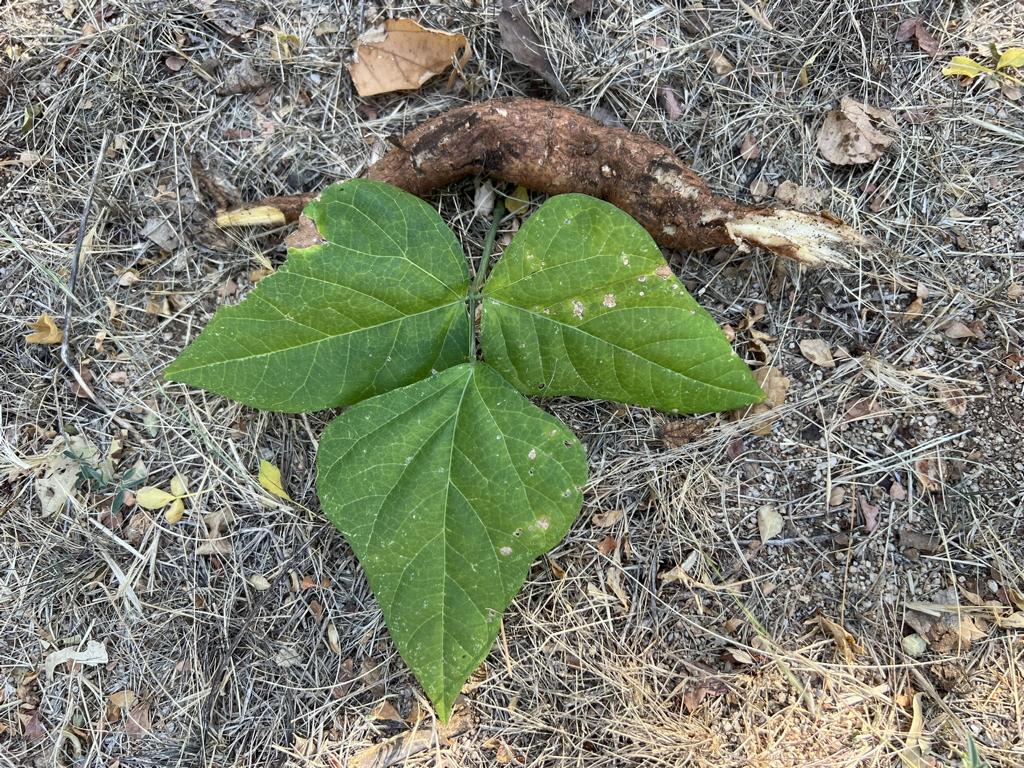
The inflorescence is a short raceme of fragrant, lavender-violet pea flowers, and the fruit is a long-shaped legume pod containing seeds.

The fusiform roots in the rootstock are covered by a thick layer of bark and store nutrients for the plant in case of bushfires. After being reduced by fire, the plant will often flower when the stems are only 7-20cm / 3-8” long and before the leaves appear.
Distribution
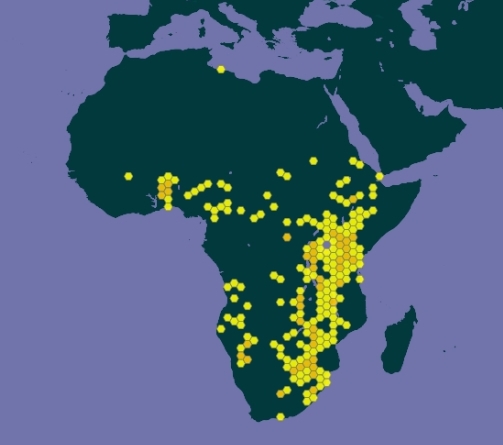
Wild Sweetpeas primarily grow in African bushveld savannah biomes, which periodically dry out. They avoid areas with higher rainfall, deserts, and low shrub growth, such as steppes and shrubland savannas.
When and how to harvest Wild Sweetpea tubers?
Wild Sweetpea tubers are available and eaten throughout the year by the Hadza, except for the latest dry and wet seasons, according to this source.

The women use wooden digging sticks to extract the tubers from the hard soil. Typically, they cut sticks from Raisin bushes (Grewia sp.) on-site for immediate use.
If available, however, the women prefer sections of rebar steel for digging. They are thinner than conventional wooden digging sticks and dig deeper at every blow. They also last a lifetime, which saves them time.
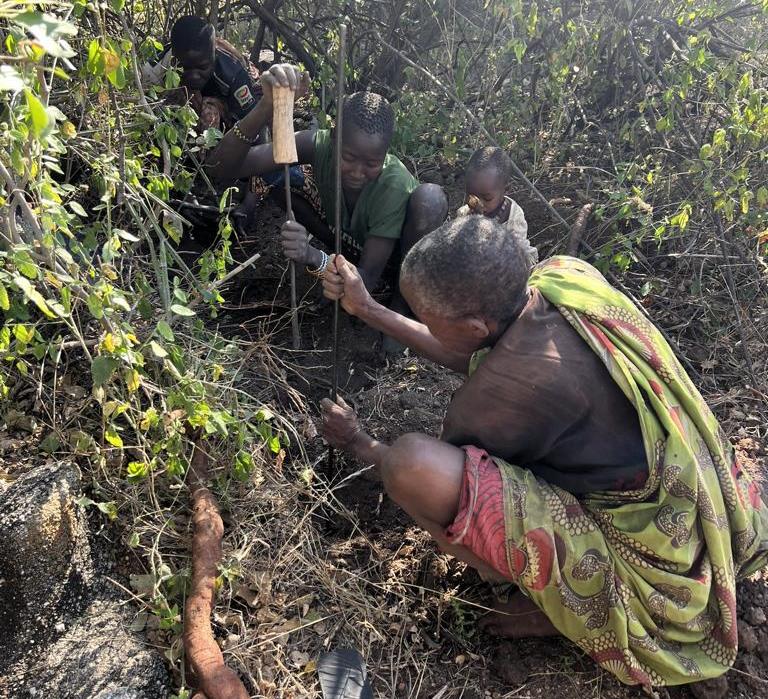
Two of the four women in our band had such rebar steel sections. One found it in the bush and added a wooden handle to it. The other one traded it against honey from the Datoga people.
How to find Wild Sweetpea tubers?
Wild Sweetpea plants are conspicuous due to their trifoliate leaves. They grow at eye level and are mixed into other shrubs and bushes.

Silvery-grey-colored, knotted, and twisted stems follow these leaves. These, in turn, lead to the base of the stem protruding from the soil. By tapping the hard soil, different sounds can be heard. When the tapping sounds hollow, people start to dig for the tubers at that place.

Wild sweetpea tubers typically grow 30-50cm / 1-1.5 ft below the surface. They are difficult to extract and, even more so, to get out without damaging the tubers.
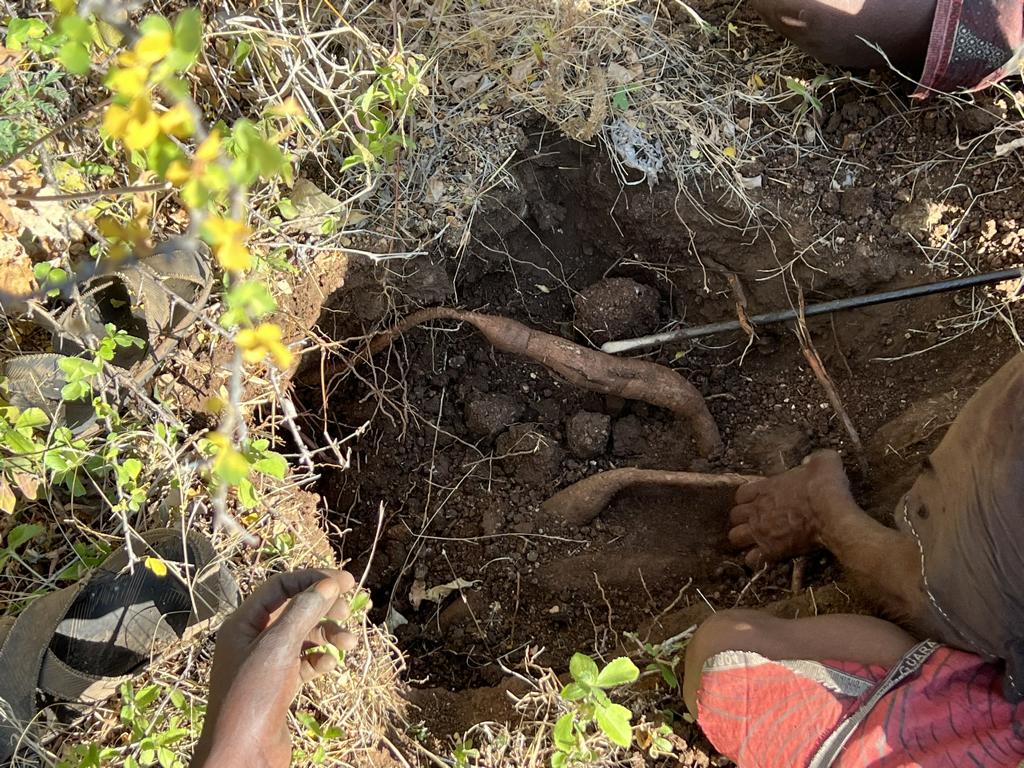
Our Hadza ladies were experienced in digging out these tubers, whereas I struggled to extract an undamaged 20cm / 8’’ long piece. Hadza people never remove all the tubers from a plant and always fill the hole with soil to harvest tubers again the following season.
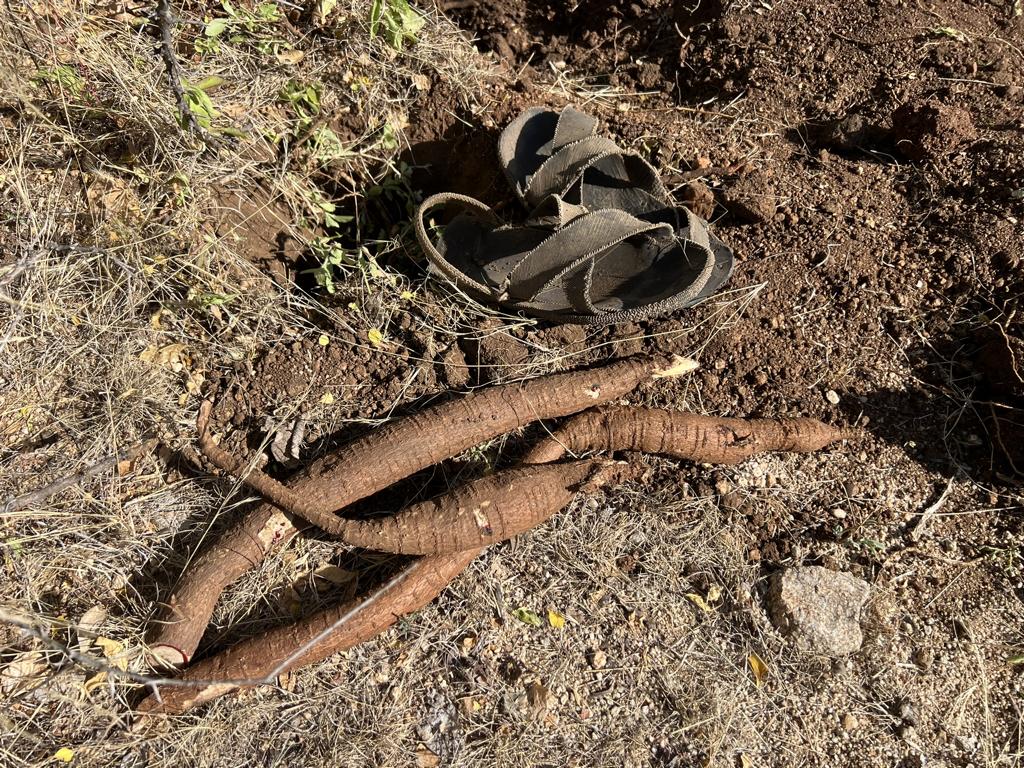
Most Wild Sweetpea stems grow under shrubs and bushes, and the soil is littered with fallen leaves and dry grass. Therefore, the most significant danger for the foraging ladies is being bitten by Puff Adders (Bitis arietans).
According to verbal information from our Hadza friends, men are mainly bitten by Eastern Green Mambas (Dendroaspis angusticeps) when collecting honey on Baobab trees and women by Puff Adders when digging for Sweetpea tubers. The government, therefore, cleared an airstrip about 5 km away from ‘our’ Hadza village to allow the Tanzanian Flying Doctors a speedy medical response. Mobile phone signals can be received on high rock outcrops.
Preparation of Wild Sweetpea tubers
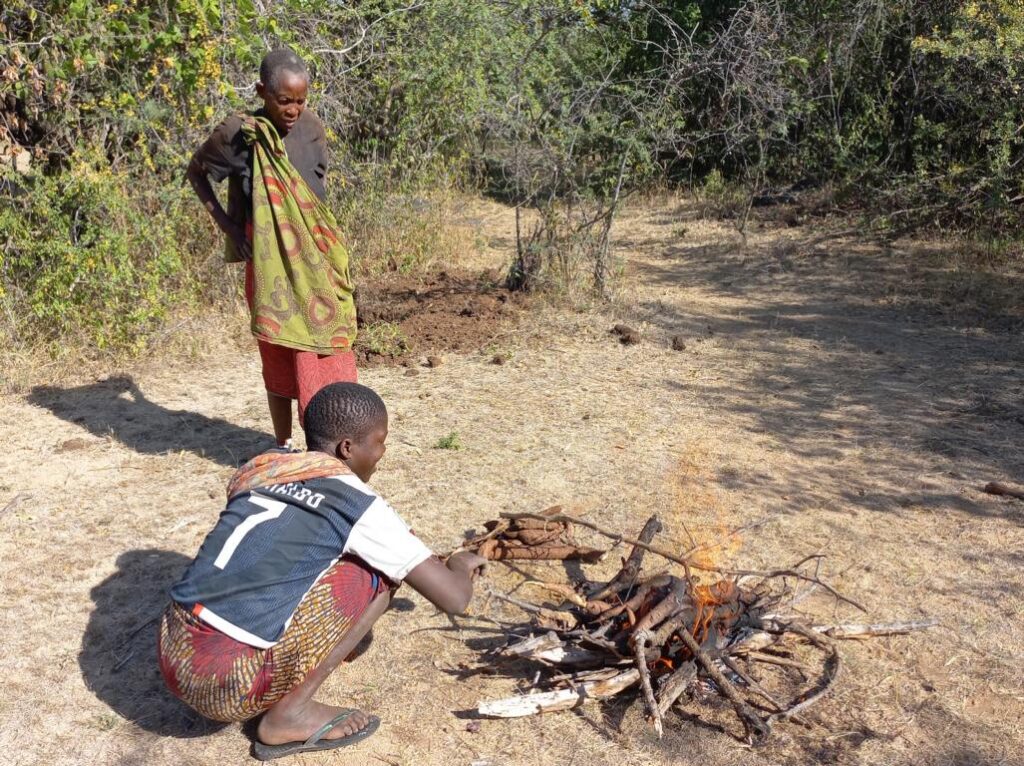
Preparing the tubers is simple. First, light a fire. With authentic Hadza people, there are no Bhutane lighters or such modern gadgets around. Every man not only carries his bow and arrows at every occasion, but with the arrows, he always adds his two firesticks. They rubbed the friction fire hand drill and started a fire within a minute.

Second, roast the tubers on the open fire when the fire is brightly burning.
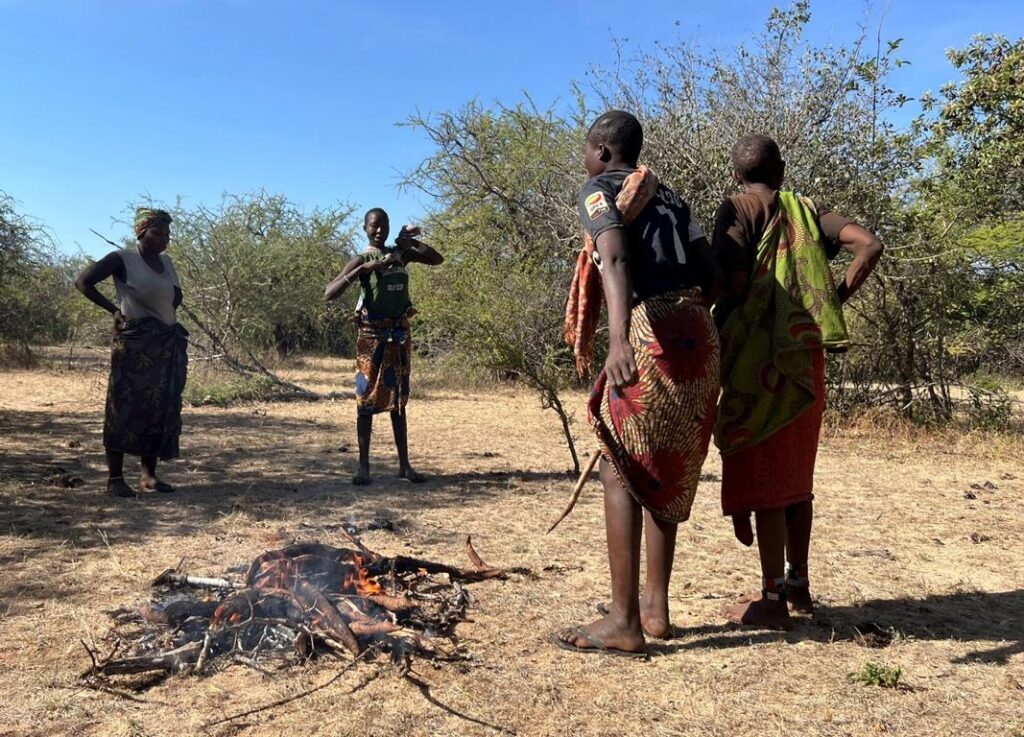
The tubers’ thick and moist bark protects the inner portion from charring. They are partly cooked in about 5 -10 minutes. At this stage, peeling off most of the bark to expose the edible yellow portion is easy. Some bark should remain on the cooked tuber for easier handling.
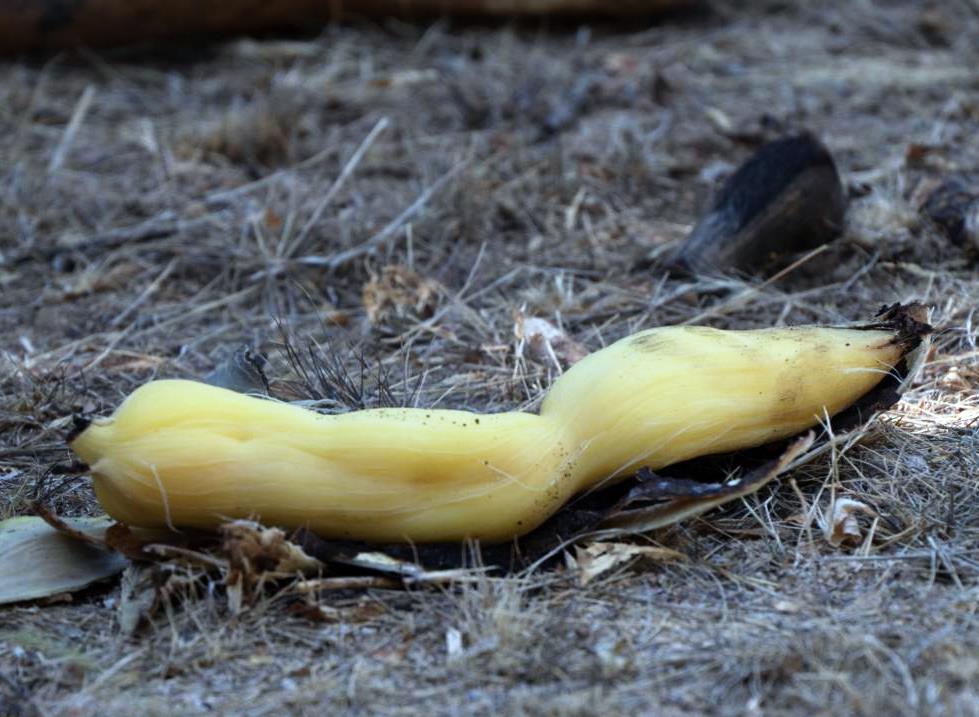
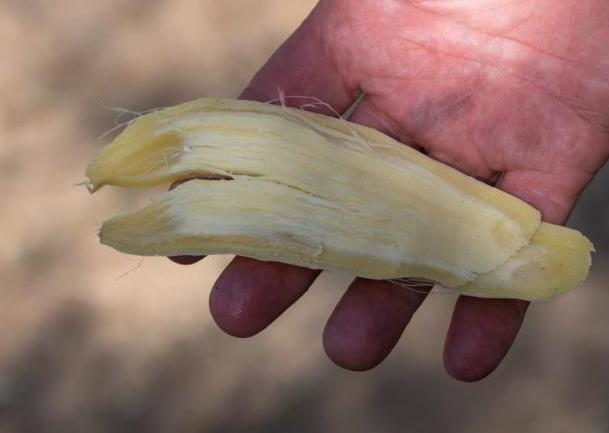
Eating Wild Sweetpea tubers

The edible portion of the roots is very fibrous. After chewing, the fibers are spat out (and the remaining ones are pulled from between the teeth 😊). Generally, the peeled roots can be eaten raw or cooked. Smaller, younger ones are often eaten raw to extract water. Older ones are either always cooked or dried and ground to powder. The fibers of such ground powder are sieved off before cooking in stew or porridge.

Nutritional value
Schoeninger et al. analyzed the composition of Wild Sweetpea tubers used by Hadza foragers and presented their findings in this article.
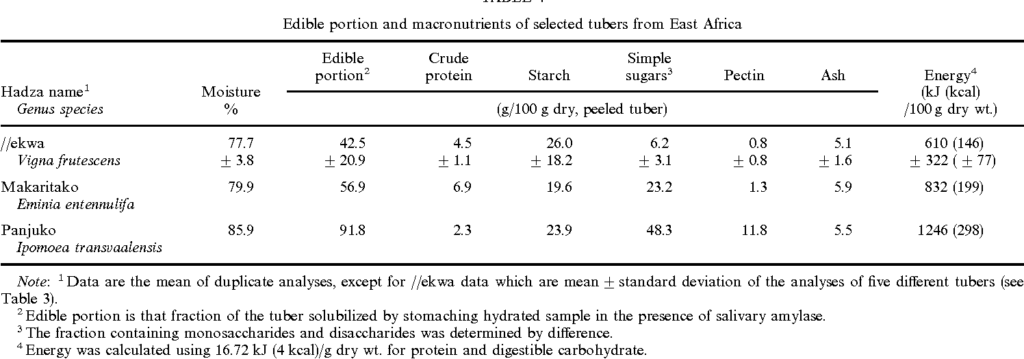
According to them, the fresh roots’ edible (peeled) portion contains about 77% moisture. Dry, peeled tubers contain 42% digestible material; the rest are fibers. From the digestible material, the protein content is 4.5%, the starch content is 26%, and mono- and disaccharides are 6.2%. The 100 g dry-weight material contains an energy of 146 kcal.
Therefore, these tubers provide a higher starch content than other available roots for the Hadzabe people but considerably lower edible portions and far lower sugar content. For a balanced diet, other complementary food sources that contain minerals and vitamins must be consumed.
Crossover from Hadza people to Khoi-San bushmen in Namibia
Khoi-San people living in remote villages in Northern Namibia dig for tubers of Cowpeas (Vigna lobatifolia) and either eat them raw or roast them. This is described in one of my articles on this website. Therefore, both hunter-gatherer tribes – Hadza and Khoi-San – eat the tubers of the same plant family.
Lessons learned from Wild Sweetpea tubers:
- Hadza people can harvest Wild sweetpea tubers throughout the year.
- The plants are easily recognizable by their distinctive leaves and stems.
- It is hard work to dig out the tubers.
- These roots can be eaten raw or cooked. Roasting on an open fire will make the bark easy to peel.
- Wild Sweetpea tubers are a starch source for the Hadza people, complementing their usual protein diet.
Additional information
My book ‘Hadzabe Survival Skills‘ offers more skills, knowledge, tools, and techniques for the Hadzabe people’s life in their natural environment. It is available on Amazon.com and Amazon’s regional websites.
How was it possible to meet a Hadza clan that still leads an authentic and sustainable life?
The NGO Ujamaa Community Resource Team (UCRT), supported by the Dorobo Fund, enabled the indigenous Hadza people near Lake Eyasi to secure land rights. Building on this foundation, the NGO Carbon Tanzania initiated, with full community participation, a carbon offset (voluntary market) project resulting in significant financial community benefits. This has strengthened community land rights & empowered the communities to implement their own development agendas.
The Dorobo Fund was established by the Peterson family. These Americans, born in Tanzania in the last two generations, have supported Hadzabe rights for several decades. Daudi Peterson et al. also published a book and Audio CD called ‘Hadzabe—By the Light of a Million Fires’ allowing the Hadza to tell their own story.
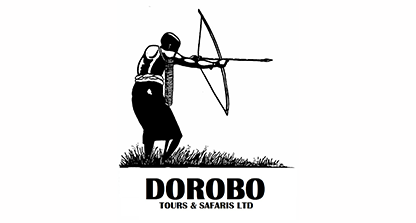
Based on the long-term trust relationship between the Hadza and the Peterson family, they agreed on mutually beneficial agreements that allow Dorobo Tours & Safaris to bring a small number of culturally sensitive tourists to visit the Hadza. Dorobo is the only company that can provide such an original experience.
Mika Peterson (son of Daudi Peterson) can be contacted at dorobo@dorobo.co.tz
.

